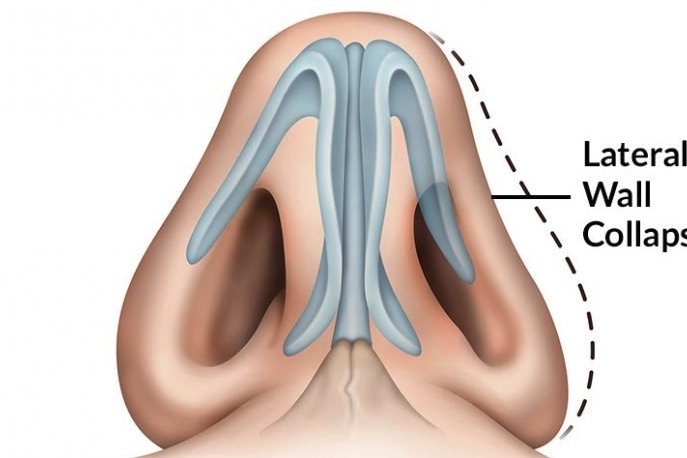The most obvious symptoms of nasal valve collapse are:
- Nasal obstruction
- Nasal congestion
- Difficulty breathing through your nose
What causes collapse of Nasal valve?
The most common cause of external nasal airway obstruction is valve collapse. The nasal valve is the narrowest segment of all nasal airways. Under normal conditions, the nasal valve collapses during deep inhalation (exertion) but remains open during normal nasal breathing. However, the valve may collapse in the presence of a thin nose, its damage, as well as in diseases of the nose, after nose surgery, or as a result of aging. This is because skeletal support of the nasal valve is insufficient and the valve collapses. Septal cartilage grafts are more commonly used to treat nasal valve collapse.
How can I know I have Nasal Valve Collapse?
We can quickly diagnose your disease, but you can also diagnose this condition at home all by yourself.
- If your breathing improves when the cheek skin is pulled towards the ear, you could have nasal valve failure.
- Breathe-Right (or similar) strips help you breathe better.
If you experience any of the symptoms mentioned above, or if you’ve come to a conclusion based on a home diagnosis, you can make an appointment with us so we can decide the best care option for you.
In some cases, a closer examination of the nose is needed to aid in the diagnosis. For an accurate diagnosis, you may need consultation of an ENT doctor, endoscopic diagnostics of ENT organs (all structures of ENT organs are examined under magnification), or rhinomanometry (a research technique which indicates how passable air is through the nasal passages).
Treatment options.
Treatment options include both non-surgical and surgical procedures.
NON-SURGICAL TREATMENT
Allergy medications (such as nasal steroid sprays and antihistamines) and Breathe-Right strips are used as non-surgical treatments. People with developed nasal muscles have better nasal breathing compared to those with rudimentary nasal muscles. Based on this principle, a technique for training the muscles of the nose according to the principle of “biofeedback” can be used.
SURGICAL TREATMENT
In surgery, the tip cartilages are rebuilt to increase their strength, and the septum is also straightened as part of the surgical procedure. The procedure is carried out through a slight incision at the base of the nose, and ear and/or septal cartilage is often used in the reconstruction.
Another method is the installation of the so-called “Expanding” grafts (spreader grafts) between the upper edges of the triangular cartilage and the cartilage of the septum of the nose.
The postoperative period is very important for the normal recovery of nasal functions. It often takes up to a week to fully recover from surgery. At Potomac ENT and Allergy, our doctors competently and professionally take care of the nasal cavity in the early postoperative period, which allows you to speed up your recovery and avoid complications.
Nasal valve collapse treatment is one of the services offered at Potomac ENT and Allergy. Contact us today to schedule an appointment.
References
Elaine K. Luo, M.D. — Written by Becky Young — September 17, Nasal Valve Collapse.
Retrieved from: https://www.healthline.com/health/nasal-valve-collapse

